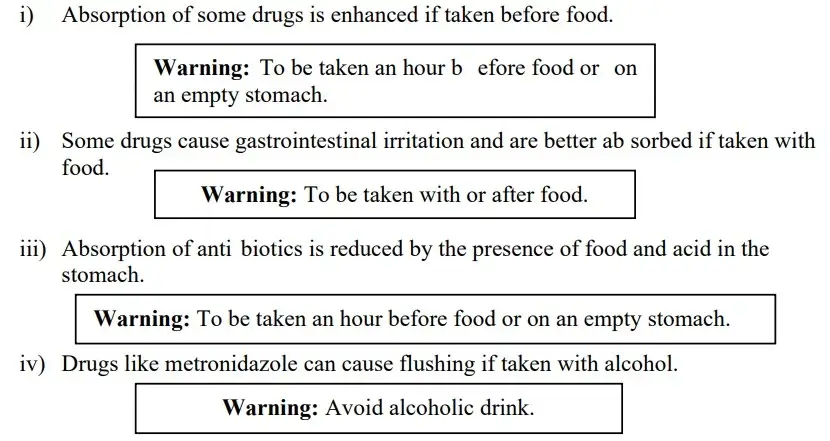The stock drugs in the ward are not labeled with the directions for use because there may be a few patients who are receiving the same medication under different therapeutic regimens. If a direction for use is labeled on the container of such drugs, the patients may get confused and may end up taking the wrong doses. Due to this reason, the stock drugs are only labeled with the ward number, name and strength of the preparation, and any other relevant information.
After a medicine is dispensed in a container, it should be labeled to provide the required information regarding the use of medicine.
The label of dispensed medicines should bear the following characteristics:
- Accurate: After writing and before fixing it to the container, the label should be checked properly.
- Legible: The information on the label should be either type-written or printed to make it easily readable.
- Intelligible: The information on the label should be unmistakable to avoid any confusion.
- Adequate and Relevant: The information on the label should be sufficiently relevant to avoid confusion. Limited but clear information should be provided on the label to make it noticeable.
The label should comply with the requirements mentioned in the Drugs and Cosmetics Act and Rules and with current professional opinions.
Preparation of Labels for Dispensed Medicines
The following information should be provided by the label on the dispensed medicines:
Name and Address of the Patient
The first name(s) or initial(s) and surname of the patient should be put on the label of each dispensed medicine to avoid confusion with other members of the patient‟s family who might be taking similar medicines.
Name and Address of the Supplier and Date of Supply
The name and address of the pharmacy from where the drug is dispensed are pre-printed on the labels. The supply date is also mentioned on the label.
Precise Details Regarding the Contents of Container when Dispensed
- Name of the Medicine: The name and strength of the dispensed medicine is mentioned on the label for safety purpose; however, sometimes it causes unnecessary anxiety and distress to the patients. The preparation name written by the prescriber (proprietary name, non -non-proprietary name, official drugs given in I.P., B.P., U.S.P., B.P.C., B.N.F., etc.) should be on the label.
- If the prescriber uses a non-proprietary name for a preparation, that name should be present on the label, even if the medicine is available as a proprietary product. If the prescribed medication has several ingredients but no official or proprietary name, the medication is labeled by its pharmaceutical form, e.g., the mixture, the ointment, the lotion, etc.
- Strength of the Medicine: The medication strength should be on the label if preparations are available in different strengths. If an official preparation has its strength mentioned in the monograph, the official publication can be referred to on the label, e.g., Calamine Lotion I. P., Sulphur Ointment I.P., Tannic Acid Glycerine I.P., etc. However, if the strength of an official preparation is not stated in the monograph, then its strength should be included in the label, e.g., Chloramphenicol Oral Suspension I.P., Chlorohexidine Cream I.P., and Aminophylline Suppositories.
- Quantity in the Container: The total quantity of the medication dispensed in the container should be given on the label. If more than one container with the same medicine is dispensed, the amount in each container should be mentioned on the label.
Storage Conditions and Shelf -Life of the Product:
The pharmacists should provide the following guidelines on the label regarding the storage conditions:
- i) Temperature: Many products need to be stored in a cool place below 15°C temperature. High temperatures can damage pessaries and suppositories that are designed to melt at body temperature. Immunological products and insulin injections should be stored between 2 -8°C temperatures. Formaldehyde should be stored in a moderately warm place.
- ii) Humidity: The solid unit dosage forms that need to be protected from moisture should be dispensed in air – and moisture-proof containers. The patients should be guided to replace the cap after every use. Powdered dosage forms should be stored in a dry place.
- iii) Light: The light-sensitive products should be stored in amber-colored containers, which should be further stored in cardboard boxes. Even light-resistant containers should not be exposed to direct sunlight.
Instructions to the Patient
The following clear and complete instructions should be provided on the label for the patients regarding the use of medication:
- Directions: The prescriber writes in the prescription the directions for use including the dose, frequency, timing, and route of the drug administration.
- Shaking of the Bottle: Emulsions, suspensions, and aerosols for internal or external use should be shaken well before use to make the preparation homogeneous. Thus, this instruction should be provided on the label of such preparations to ensure dosage accuracy.
- Take with Water: Mixtures that can cause gastrointestinal irritation or mixtures for geriatrics having a dose of 10ml or more should be diluted with water before administration. Medicines for pediatrics having a dose of 5ml are not diluted; however, the preparations irritating need to be diluted.
Cautionary and Advisory Labels
To make the patients take their medicine safely and effectively, they should be provided with essential information. The following instructions should be given on the label:
For External Use Only
This label should be applied on the containers of liquid preparations and all semi-solid and solid medicinal products, like gels, ointments, creams, pastes, and dusting powders, to be used externally.
Not to be Taken
This label should be applied on preparations not meant for oral intake or topical use. It is used for preparations meant for internal use, e.g., medicines for rectal, vaginal, or nasal application. The labels, „For nasal use only‟, „For rectal use only‟, or „For vaginal use only‟, are preferred over „For external use only‟.
Drowsiness Warning
Some medicines can cause drowsiness, dizziness, and blurred vision, or may impair the ability to drive or operate machinery safely. The patients should be warned about these indications while the medicines are being dispensed. The following instructions should be written on the label:

Potential Interactions with Food or Drink:
The following instructions should be written on the label:

Potential Interactions with Other Medicines
The following instructions should be written on the label:

Special Methods of Administration
The following instructions should be written on the label if a drug is to be administered by a special method.
Cautions in Use
The following instructions should be written on the label to warn a patient about the uncommon incidents that may occur on taking some medicines.
Related Links
